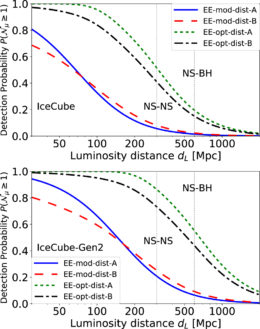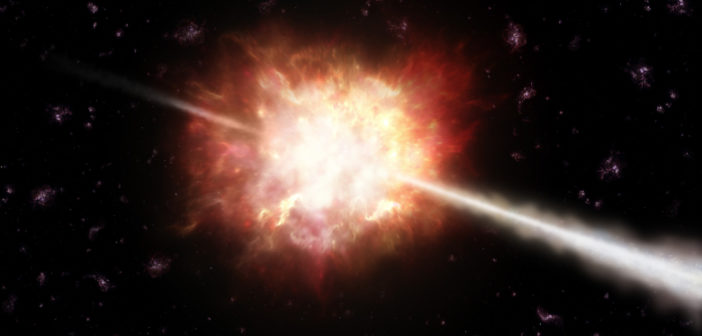With the first detection of gravitational waves in 2015, scientists celebrated the opening of a new window to the universe. But multi-messenger astronomy — astronomy based on detections of not just photons, but other signals as well — was not a new idea at the time: we had already detected tiny, lightweight neutrinos emitted from astrophysical sources. Will we be able to combine observations of neutrinos and gravitational waves in the future to provide a deeper picture of astrophysical events?
Signs of a Merger

Artist’s impression of the first stage of a binary neutron star merger. [NASA, ESA, and A. Feild (STScI)]
- gravitational waves as the binary spirals inward,
- a brief burst of gamma rays at merger (this is the SGRB),
- high-energy neutrino emission during the SGRB,
- optical and infrared emission after the merger in the form of a kilonova, and
- radio afterglows of the merger remnants.
While we’ve observed the various electromagnetic components of this picture, the multi-messenger part is lacking: gravitational-wave detections haven’t been made in conjunction with electromagnetic counterparts thus far, and the only confirmed astrophysical sources of neutrinos are the Sun and Supernova 1987A.
Can we expect this to change in the future? A team of authors led by Shigeo Kimura (Pennsylvania State University) has now explored the likelihood that we’ll be able to detect high-energy neutrinos in association with future gravitational-wave events.Detecting the SGRB Neutrinos
Kimura and collaborators first estimate the flux of high-energy neutrinos expected during various emission phases of an SGRB. They show that a period of late-time emission, known as the “extended emission” phase, may produce high-energy neutrinos more efficiently than the other phases. But would we be able to see these neutrinos?

A comparison of IceCube’s detection capabilities (top) to those of the planned IceCube-Gen2 (bottom), for different models of neutrino emission during an SGRB. [Kimura et al. 2017]
The authors’ calculations suggest that within several years of operation of IceCube-Gen2, there is a good chance that we’ll be able to simultaneously detect gamma rays, neutrinos, and gravitational waves from bright SGRBs. This will provide us with powerful tools for learning about the physics of these energetic events.
Citation
Shigeo S. Kimura et al 2017 ApJL 848 L4. doi:10.3847/2041-8213/aa8d14



2 Comments
Pingback: neutrinos and gravitational waves together
Pingback: Neutron-Star Merger Detected By Many Eyes and Ears